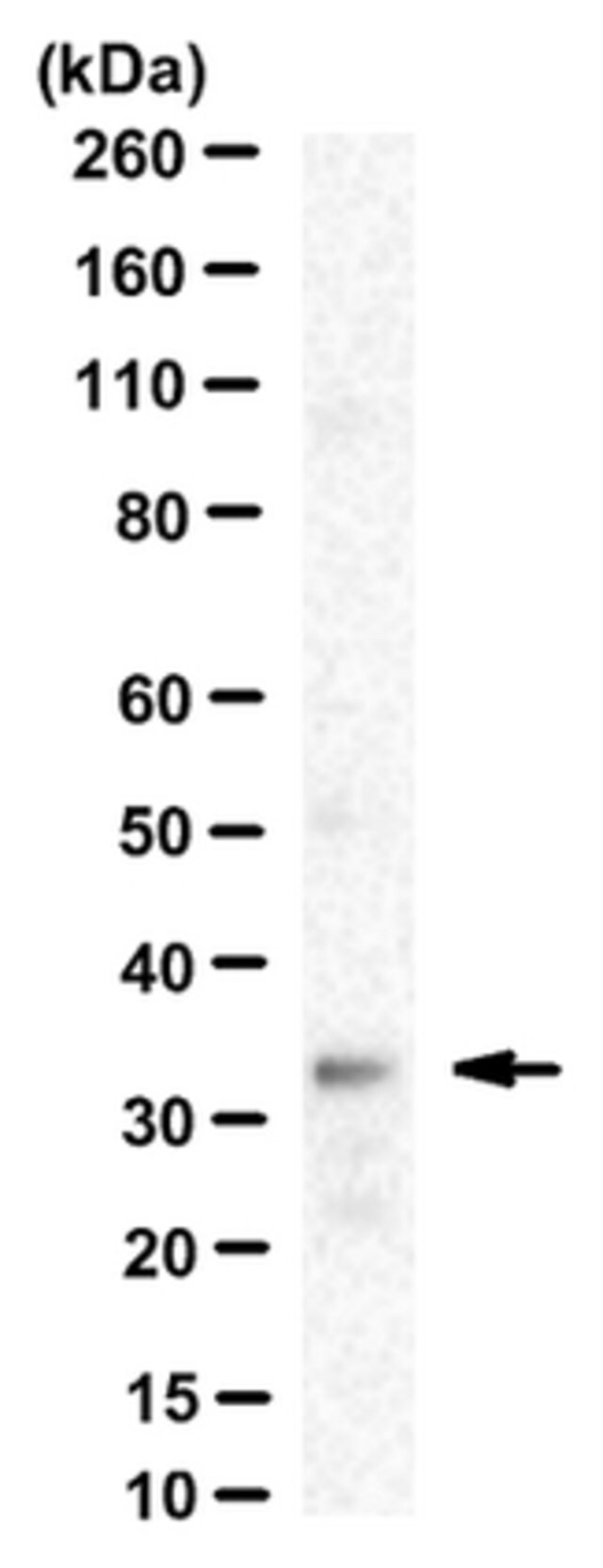您的位置:首页 > 产品中心 > Anti-GnRH-R Antibody, clone F1G4
Anti-GnRH-R Antibody, clone F1G4

产品别名
Anti-GnRH-R Antibody, clone F1G4
Gonadotropin-releasing hormone receptor, GnRH receptor, GnRH-R, Leutinizing hormone-releasing hormone receptor, Luteinizing-releasing hormone receptor
基本信息
| eCl@ss | 32160702 |
| NACRES | NA.41 |
| General description【一般描述】 | Gonadotropin-releasing hormone receptor (UniProt P30968; also known as GnRH receptor, GnRH-R, Leutinizing hormone-releasing hormone receptor, Luteinizing-releasing hormone receptor) is encoded by the GNRHR (also known as GNRHR1, GRHR, LHRHR, LRHR) gene (Gene ID 2798) in human. GnRH-R belongs to the family of seven-transmembrane G-protein coupled receptors (GPCRs). GnRH-R resides primarily in the pituitary and is responsible for eliciting the actions of GnRH (also known as Luteinizing hormone-releasing hormone or LHRH) after its release from the hypothalamus. Luteinizing hormone (LH) is then secreted from gonadotropes of the anterior pituitary into the bloodstream following pulsatile stimulation of GnRH-R by GnRH/LHRH. The canonical GnRH-R designated by UniProt (P30968-1) corresponds to a 328-amino acid sequence that includes 4 extracellular domains (a.a. 1-38, 98-115, 185-212, 233-281), 7 transmembrane segments (a.a. 39-58, 78-97, 116-137, 165-184, 213-232, 282-300, 307-326), 4 intracellular domains (a.a. 59-77, 138-164, 233-281, 327-328). Multiple GnRH-R variants and post-translationally processed forms are reported in human brain samples. |
| Specificity【特异性】 | Specificity of clone F1G4 was demonstrated by tissue-specific staining and by immunogen peptide blocking (Karande, A.A., et al. (1995). Mol. Cell. Endocrinol. 114(102):51-56). |
| Immunogen【免疫原】 | BSA-conjugated linear peptide corresponding to the N-terminal sequence of human GnRH-R. Epitope: N-terminal extracellular domain. |
| Application【应用】 | Detect GnRH-R using this Anti-GnRH-R Antibody, clone F1G4 validated for use in Western Blotting, Dot Blot, ELISA, Flow Cytometry, Immunohistochemistry (Paraffin). Research Sub Category Hormones & Receptors Research Category Neuroscience Dot Blot Analysis: A representative lot detected the immunogen peptide by dot blot (Karande, A.A., et al. (1995). Mol. Cell. Endocrinol. 114(102):51-56). ELISA Analysis: A representative lot detected the immobilized immunogen peptide by ELISA (Karande, A.A., et al. (1995). Mol. Cell. Endocrinol. 114(102):51-56). Flow Cytometry Analysis: A representative lot detected surface GnRH-R immunoreactivity on live human breast carcinoma T47D and ovarian carcinoma OVCAR-3 cells. Most likely due to low affinity antibody binding or unoptimized antibody concentration used, only ~50% of the T47D and ~10% of the OVCAR-3 populations were stained (Karande, A.A., et al. (1995). Mol. Cell. Endocrinol. 114(102):51-56). Immunohistochemistry Analysis: A rerepsentative lot detected GnRH-R expression on gonadotropin-producing endocrine cells (gonadotropes) in pituitary, as well as among neurons in human hippocampus and neocortex, using formalin-fixed, paraffin-embedded human tissue sections (Wilson, A.C., et al. (2006). J. Endocrinol. 191(3):651–663). Immunohistochemistry Analysis: A rerepsentative lot detected similar hippocampus GnRH-R immunoreactivity among Alzheimer′s diseased (AD) and age-matched control brain sections, while significanly decreased GnRH-R immunoreactivity associated with the apical dendrites of pyramidal neurons was seen in the AD brain using formalin-fixed, paraffin-embedded tissue sections (Wilson, A.C., et al. (2006). J. Endocrinol. 191(3):651–663). Immunohistochemistry Analysis: A rerepsentative lot detected GnRH-R-positive cells in the anterior pituitary, but not the posterior pituitary using frozen human brain sections. Pre-blocking with immunogen peptide abolished the antibody staining (Karande, A.A., et al. (1995). Mol. Cell. Endocrinol. 114(102):51-56). Western Blotting Analysis: A rerepsentative lot detected the expression of multiple GnRH-R variants in human cortex and pituitary tissue lysates, including the most prominent 30 kDa, 64 kDa, and 136 kDa bands. The 136 kDa band was seen significantly downregulated in the cortex, but not pituitary from Alzheimer′s diseased (AD) brain when compared to age-matched control (Wilson, A.C., et al. (2006). J. Endocrinol. 191(3):651–663). |
| Quality【质量】 | Evaluated by Western Blotting in human pituitary tissue lysate. Western Blotting Analysis: 2.0 µg/mL of this antibody detected GnRH-R in 10 µg of human pituitary tissue lysate. |
| Physical form【外形】 | Format: Purified Purified mouse monoclonal IgG1λ antibody in buffer containing 0.1 M Tris-Glycine (pH 7.4), 150 mM NaCl with 0.05% sodium azide. Protein G Purified |
| Other Notes【其他说明】 | Concentration: Please refer to lot specific datasheet. |
产品性质
| Quality Level【质量水平】 | 100 |
| biological source【生物来源】 | mouse |
| antibody form【抗体形式】 | purified immunoglobulin |
| antibody product type | primary antibodies |
| clone【克隆】 | FIG4, monoclonal |
| species reactivity | human |
| technique(s) | ELISA: suitable dot blot: suitable flow cytometry: suitable immunohistochemistry: suitable (paraffin) western blot: suitable |
| isotype【同位素/亚型】 | IgG1λ |
| NCBI accession no.【NCBI登记号】 | NP_000397 |
| UniProt accession no.【UniProt登记号】 | P30968 |
| shipped in【运输】 | wet ice |
产品说明
| Target description【目标描述】 | ~34 kDa observed. Clone F1G4 was reported to detect multiple GnRH-R variants and posttranslationally processed forms in human brain samples (Wilson, A.C., et al. (2006). J. Endocrinol. 191(3):651–663). |
| Storage and Stability【储存及稳定性】 | Stable for 1 year at 2-8°C from date of receipt. |
| Disclaimer【免责声明】 | Unless otherwise stated in our catalog or other company documentation accompanying the product(s), our products are intended for research use only and are not to be used for any other purpose, which includes but is not limited to, unauthorized commercial uses, in vitro diagnostic uses, ex vivo or in vivo therapeutic uses or any type of consumption or application to humans or animals. |
安全信息
| Storage Class Code【储存分类代码】 | 12 - Non Combustible Liquids |
| WGK | WGK 1 |




